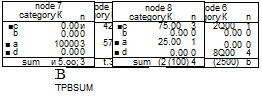The results of the classification-tree analysis are shown in Fig. 5. First, urban parks were divided into two branches according to the proportion of surrounding woodland within 500 m. All urban parks of type B and two parks of types A and C were classified into a branch for which the proportion of surrounding woodland is 5.9% or less, while all parks of type D and the other parks of type A and C were classified into another branch with greater than 5.9% surrounding woodland. The former branch was divided by SPBSUM. The SPBSUM values of all urban parks of type B were 37.5 or less. The latter branch was divided by the area of vegetation cover. All urban parks of type D and one park of type C had an area covered by vegetation of more than 0.21 ha. The other branch (area of vegetation cover <= 0.21 ha) was divided by TPBSUM (splitting point is 1).
Using-layer selection
The using-layer selection is shown in Fig. 6. It was selected seven major species recorded more than 15 individuals. The heights at which birds were observed were classified into four layers: ground (0 m), herb and shrub (0-3 m), sub-tree (3-9 m) and tree (9+ m) layers. Most individuals
 |
of Columba livia var. domestica and Passer montanus were found on the ground. Most individuals of Hypsipetes amaurotis, Zosterops japonicum, Parus major and Corvus macrorhynchos used the sub-tree and tree layers.
 |
 |
area of vegetation cover within urban park
 |
<=0.21 >0.21
Fig. 5. Results of the classification-tree analysis
Discussion

